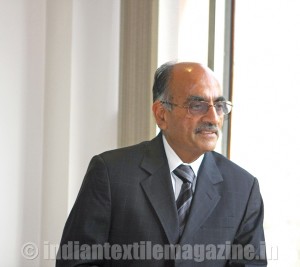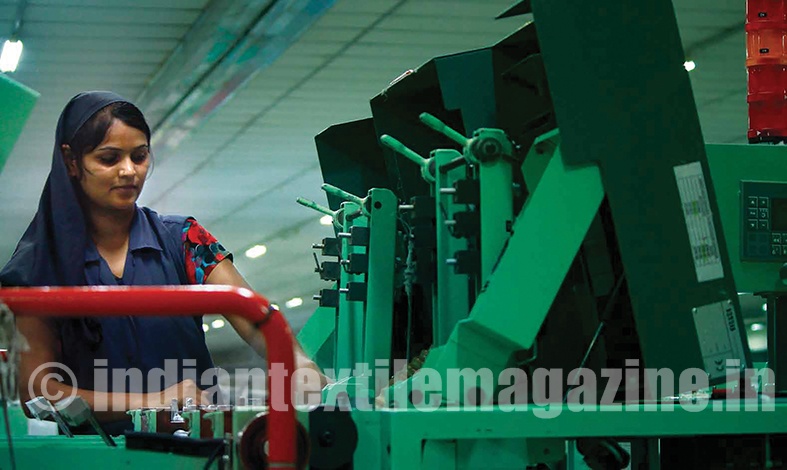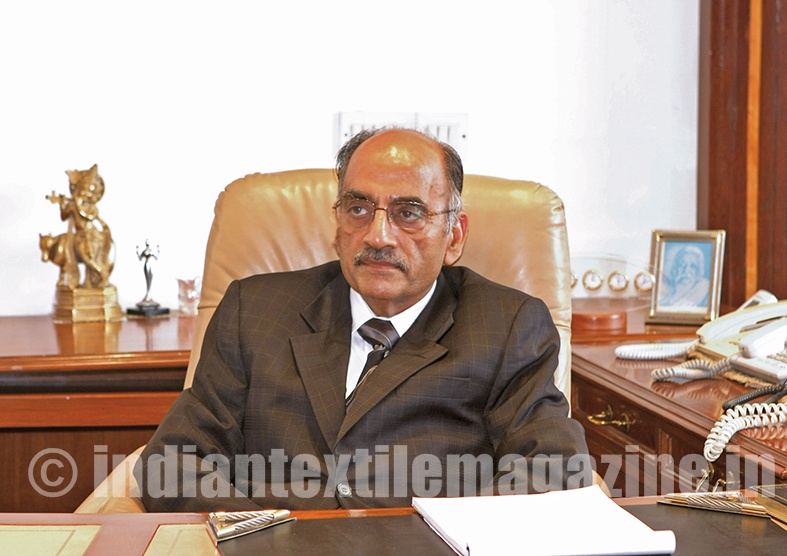Vardhman Textiles Ltd. is now in the midst of expansion in fabric capacities, part of which, a printing line, already commenced commercial production in March last. This phase of expansion will be rolled out over the next three years, including the current financial year, and will entail a capex of approximately Rs. 1,000 crores towards increasing weaving (looms) capacities as well as raising yarn dyed and printing fabric capacity, besides some line balancing equipment. The company, which is also contemplating the next leg of expansions which would be in spinning and fabrics, clocked a turnover of Rs. 5,587.14 crores during 2015-16.

Vardhman Textiles is the flagship company of an integrated textile manufacturing group with an extensive presence across the value chain, from the manufacture of fibres and yarns to sewing threads and fabrics. A few years ago, the group entered the garment manufacturing business through a collaboration with Nisshinbo Textile, Inc. (Japan).
The Vardhman Group has 22 manufacturing facilities across India, employing more than 25,000 people. The company has global alliances with leading textile companies such as American & Efird Global LLC (USA), Marubeni Corporation (Japan) and Nisshinbo Textile, Inc. (Japan).
Yarn
Vardhman, along with its subsidiaries, is one of the largest yarn producers in India, manufacturing and dyeing fibres from 12 different facilities located across Punjab, Himachal Pradesh and Madhya Pradesh. Vardhman is the leading manufacturer and exporter of cotton yarn as well as of piece-dyed fabric. It is also the second largest producer of sewing threads and market leader in the area of hand-knitted yarns.
The company’s yarn product basket is divided into three categories – commodity, compact and specialized yarns – and delivers the widest range of specialized greige and dyed yarns (cotton, polyester, acrylic and other blends). The company’s yarn business is its largest revenue generator – accounting for nearly 60 per cent of its topline.
The company’s yarn consumption is divided equally for domestic, international and captive fabric consumption. It is one of the largest cotton yarn exporters to quality-conscious markets like the EU, the US and the Far East.
Approximately 70 per cent of the yarn revenues are relationship-based, providing long-term revenue visibility. Vardhman has capacity of more than a million spindles, including 7,188 rotors. Currently 68 per cent of its spindles are less than 10 years old.
Fabrics
This value-added component of Vardhman’s business makes a significant contribution to profitability. The company’s 1,316 looms and 114 million metres of fabric processing infrastructure (including printing line) are spread across five facilities in two locations. Currently 68 per cent of Vardhman’s looms are less than 10 years old.
The company’s product basket comprises fabrics for tops (shirts) and bottoms (trousers), specialised fabrics like yarn-dyed, special white and also finished fabrics with effects like liquid ammonia, teflon/nanocare (an oil and water-repellent). It is also a leading manufacturer of lycra based products in India.
The company’s customers include prominent apparel makers like Esprit, GAP, Banana Republic, Old Navy, H&M and Benetton. Exports constituted about 32.52 per cent of the company’s fabric sales in 2015-16.
During the last two challenging years for the global textile industry, a number of players deferred investments and aspired for the status quo. Vardhman Textiles strengthened its business instead. It replaced conventional technology with contemporary equivalents. As against merely increasing production capacity, the company strove to enhance the output quality. As against volume growth, it worked towards increasing value-addition.
Vardhman focused on automating its processes to enhance productivity, reliability and quality. The company has installed systems to enhance productivity and machine longevity and automated solutions across operations, minimizing human intervention.
Vardhman realigned standard operating protocols (manufacturing and non-manufacturing processes) in line with the best global practices. It institutionalised periodic operational audits in line with SOPs and invested in the visualization of key shopfloor operating parameters leading to realtime monitoring and faster corrective action.
Vardhman institutionalised a systematic asset review to trace and arrest technology obsolescence and invested in top-of-the-line equipment to provide unique fabric finishes. The company has revamped its IT network including technological upgradation for speedy execution of business transactions and invested in augmenting communication systems across all locations for seamless human collaboration.
Vardhman’s yarn production increased from 190,009 metric tonnes in 2014-15 to 204,142 metric tonnes in 2015-16. Greige fabric production increased from 170 million meters in 2014-15 to 175 million meters in 2015-16 and processed fabric production increased from 110 million meters in 2014-15 to 112 million meters in 2015-16.
Interview with Shri Paul Oswal
Were you happy with the company’s performance in 2015-16?
Yes. The management was pleased even as headwinds persisted that moderated our topline (2.07 per cent decline over the previous year). Despite this reality that should have potentially hurt our earnings, our total EBIDTA increased 19.44 per cent, from Rs. 1,099.66 crores in 2014-15 to Rs. 1,313.42 crores in 2015-16; our operating EBIDTA (which excludes dividend and investment income) increased 8.53 per cent, from Rs. 1,054.89 crores in 2014-15 to Rs. 1,144.89 crores in 2015-16. Our business health improved. Total EBIDTA margin improved by more than 400 bps and return on capital employed by more than 150 bps to 20.68 per cent in 2015-16.
What were the factors behind this kind of profitable growth in operating margin?
Essentially, the organization-wide consolidation. We implemented multiple projects to benchmark our systems and process with the best global practices. The initiative yielded heart-warming returns: we enhanced output, strengthened productivity, optimized costs, eliminated waste and strengthened the productmix. When we embarked on this journey, most of these improvements were considered unattainable. Now the organisational mood is ‘Nothing is impossible’.
Vardhman’s financial performance was relatively unaffected by headwinds. How do you explain this?
We are a large company with multiple product lines and multiple customers. Our quality focus had positive impact: we accessed larger and better customers, which strengthened volumes. We marketed directly to yarn users (as opposed to doing so through market intermediaries). This strengthened realisations and a first-hand understanding of market trends. By the virtue of vertical integration, we could shift from the manufacture of yarn to fabric-based on prevailing margins. The result was that despite our presence in a yarn surplus geography, we experienced a shortage of capacity.
Following the decline in polyester prices, how was cotton demand affected?
The shift is continuous. The world over, the proportion of synthetic fibres in the consumption mix is increasing and this trend is likely to sustain. Since you can get enhanced qualities in fabric following the blending of synthetic fibres with cotton, consumption of a number of fibres is increasing. At Vardhman, we are not ‘married’ to cotton. We are increasing the blended yarn capacity; our fabric range comprises a sizable range of cotton tencels, cotton modals, cotton polyester and cotton stretch, among other products.
The proportion of blended products in our sales mix has increased – in yarn from 24 per cent to 31 per cent in the last five years, and in fabrics from 29.35 per cent to 44.33 per cent over the same period.
When is the balance between polyester and cotton likely to tilt in favour of the former?
The relationship between Cotlook A index and international polyester staple fiber prices is best explained in the 1:1.3 ratio. If the ratio exceeds this tipping point, polyester and synthetic yarn consumption generally increases. Following the decline in crude oil prices, we are at 1:1.7, indicating a consumption preference for man-made fibres translating into a sizeable increase in the production of blends and non-cotton yarn.
Cotton prices have started moving up. How has that impacted the industry?
A sharp increase in Indian cotton cost generally has no impact on yarn realisations. However, we are aware that when this transpires, a number of yarn companies could start shutting production. This transpired in India towards the latter part of 2015-16, which arrested a significant decline in yarn prices. In India, cotton production, as estimated by CAB, was 33.8 million Indian bales in 2015-16 against 38.6 million bales in the previous year. In the beginning of the season, Indian cotton prices were low and hence competitively placed in the international market. This helped India in exporting 6.7 million bales from October-March 2016. In the latter half (April 2016 onwards), Indian prices increased due to a shortage in supply, accelerating capacity closures over the medium-term that could strengthen yarn realisations in India. However, Vardhman follows a conservative policy for stocking cotton for off-peak season.
Is the company waiting to capitalise on this scenario?
The Indian textile industry is expected to provide asset consolidation opportunities. The RBI and banks are becoming more stringent in cleaning non-performing assets off their books; banks are assuming control of stressed assets for onward sale that could help recover dues, providing attractive acquisition opportunities.
How does the company intend to capitalise?
We intend to invest about Rs. 1,000 crores across three years in expanding our fabric (printing line and yarn dyed) capacity. The company enjoys a leadership position in the yarn business (domestic and international), which will be strengthened through de-bottlenecking and equipment addition. Our focus is on attaining a dominant position in the high-marg in fabrics business through capacity addition of about 45 million meters, of which 10 million meters will comprise printed fabric line expected to go on stream in the current financial year (full impact 2017-18 onwards). We are also contemplating the next phase of expansion.

